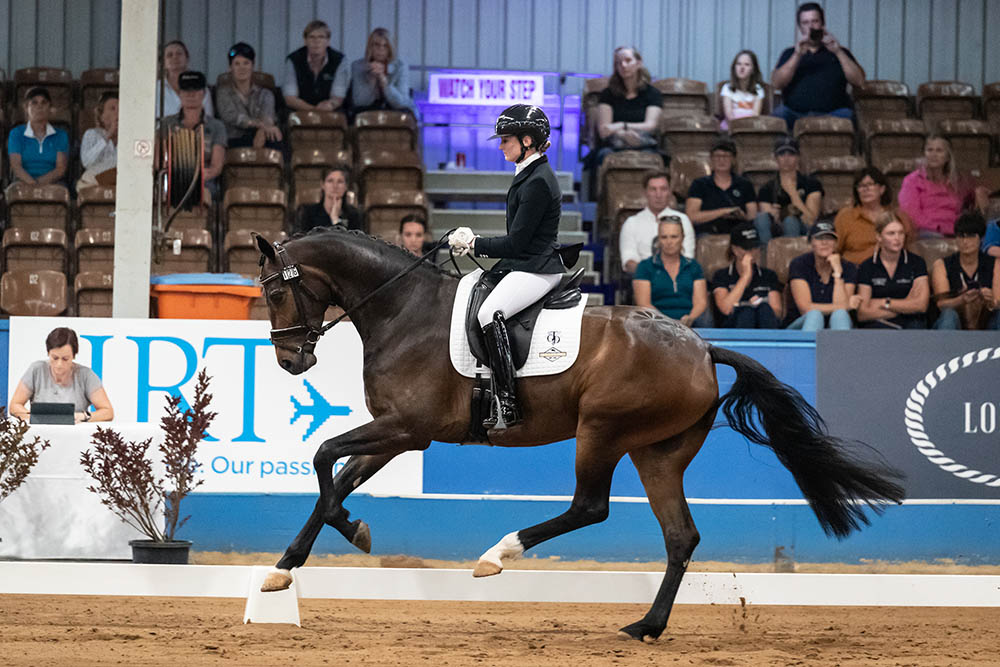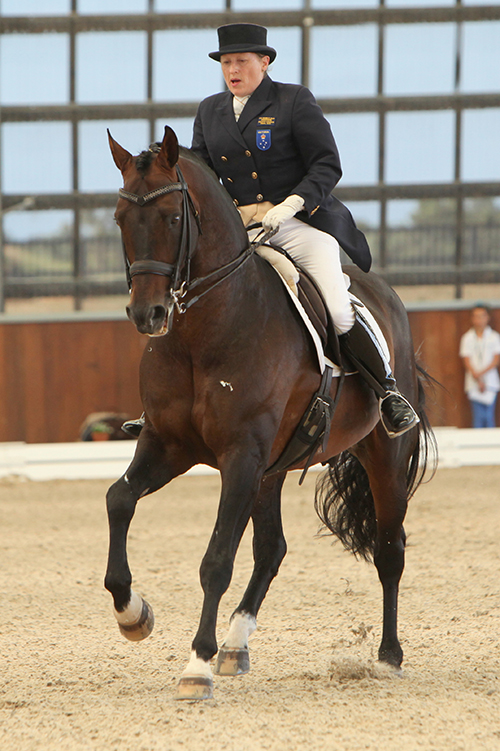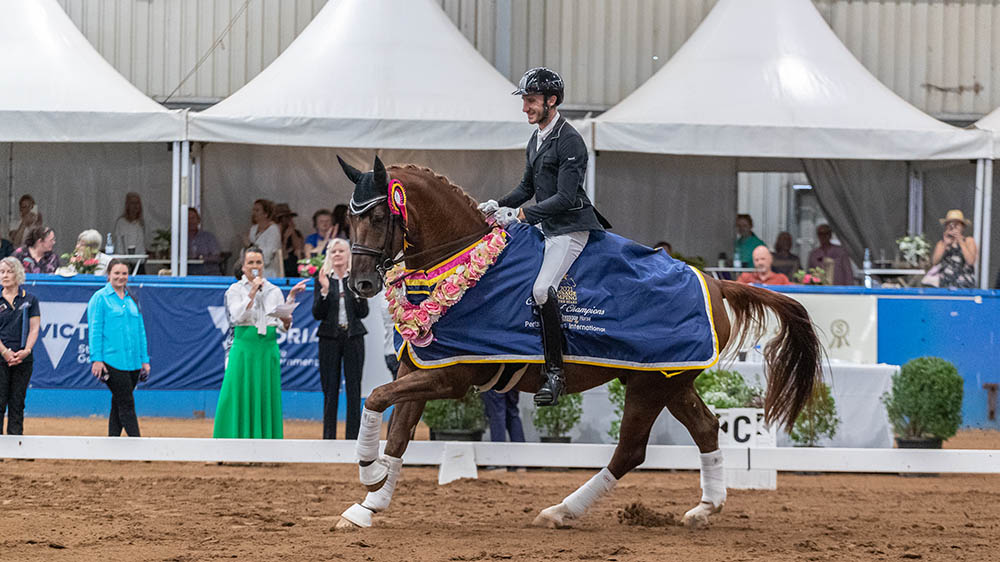Young horse classes are a great opportunity for you and your young horse to have a lot of fun and gain experience in a competitive atmosphere. Preparation is what it is all about.

Young horse classes are a highlight of the many exciting events on the equestrian calendar at this time of the year. These are classes where youngsters are introduced to the big arena atmosphere and competition. Dressage & Jumping With The Stars (DJWTS) is one such opportunity for a youngster to discover competition and experience all the atmosphere of a grand venue.
You can let your young horse take it all in over three or four days, layering one day after the other to reinforce the experience and build confidence. Hopefully, he goes home having had a good experience and gained confidence in understanding what is required in a challenging environment.
DJWTS in Melbourne from 24-26 March 2022 is the Australian Young Horse Championships and a qualifier for the World Young Horse Championships. Other states have similar classes and qualifiers at their big shows, where performances also count towards selection for the World Championships.
At these classes, young dressage horses get plenty of time to go into the ring for arena familiarisation. They then do the preliminary test in groups of two or three so they have some company to help them be brave and build confidence. They get to walk on a long rein at the end of the test before they leave the arena, which helps them learn to associate the arena with relaxation. Then they do the final test all alone, either in the main arena or the consolation arena, building on what they achieved the day before. If they get to the final in the main arena (usually the top 10), it may be that they don’t get to experience that level of atmosphere in an arena again for several years, not until they are doing the FEI classes.
Now, the thing is that if you want to perform at your best at these shows, the preparation is really important. Remember that useful acronym — PPPPP — Perfect Preparation Prevents Poor Performance. It’s time to start the preparation for DJWTS 2023 if that is your goal. If you are preparing for this year’s DJWTS, still keep reading, because if you are preparing a 4-year-old this year, it’s likely that you will be preparing a 5-year-old next year.

NEVER BE IN A RUSH
You should never be in a rush when you are training young horses. Don’t be in a rush when you are working your horse, and don’t be in a rush to reach the goals you set. Set the goal and work out a plan. Remember that, yes, the young horse classes are fun and are a great goal, but the main game really is training your horse to be a reliable and happy partner to do whatever you want to be doing. Or, if he isn’t suited for your ambitions, that he is a reliable partner for someone who wants to do the job that he is best suited for. Maybe you want a Grand Prix partner but he may be better suited to being a Medium-level schoolmaster. Young horse classes finish at 7-year-old. His career will go on for more than a decade after that. So set the young horse class as a goal but keep the bigger picture in mind and be flexible.
If you want to compete as a 4-year-old, you could consider starting his training in his 3-year-old-year. Start with small, short lessons that do not wear him out. Early work should be more like play for children and young horses. You can teach him a lot from the ground before he is backed. Teach him to relax in the face of new things. Introduce strange things and build his confidence. Teach him to approach strange things with positive reinforcement. Try to do this without frightening him. Do not use flooding techniques, such as sacking-out, that teach him to tolerate stresses, because he can’t get away.
You can put tarpaulins and wheelbarrows and umbrellas in your arena and encourage him to explore them and reward his approaching them with friendly scratches and treats. You can help him learn to have a comfortable balance and contact on the lunge, again before he is backed.
When he is under saddle, remember that short lessons are best. My rule of thumb is that, if at all possible, a young horse should not work to the point of heavy sweat. You will progress more quickly if he doesn’t get tired and want to stop. If he does what you want, don’t be greedy and keep asking for more until he makes a mistake – put him away.
Learn the tests yourself early so you can familiarise yourself with the lines. The 4-year-old tests are quite straightforward, but the 5-year-old tests have some unexpected lines that can come up very quickly. These tests have the stretchy circles: a 20-metre circle at trot where the horse must stretch forwards and down when you allow the rein to lengthen. The rhythm should stay the same; he should not speed up when you let go of the rein. His nose should be down to the level of the point of the shoulder or lower, but not down on the ground. His nose should be in front of the vertical. You should be able to do this quickly. You only have a circle in the 4-year-old or a half a circle in the 5-year-old to stretch out and rebalance, so let that rein out as fast as you can and as fast as he will follow it. He needs then to accept resuming the contact willingly.

“Keep in mind the Training Scale.”
REMEMBER THE TRAINING SCALE
Keep in mind the Training Scale – Rhythm, Suppleness, Contact, Impulsion, Straightness, Collection – in that order of importance. The thing that is implicit in the training scale is balance. In practice it is Rhythm, Suppleness and Contact that count in young horse classes. The 6-year-olds have a chance to show their potential for collection. The young horse classes are a chance for the horses with the extravagant, expressive movement to shine.
However, correct rhythm must be maintained. Do not push him out of his balance trying to make the paces more expressive than he can manage. Rather, just train correctly with lots of little transitions within the pace while developing his balance. Make sure that you are focusing on building his capacity to maintain his balance in the transitions between the paces. Show his suppleness with ending in the corners, circles and any lateral work in the test. Work on a steady, soft contact with nice, still hands for a still mouth. Carry your hands towards his mouth.
It is very useful to teach your 4-year-old the leg-yielding even though it is not required until the 5-year-old tests. You will need to keep him straight in the ring and want him to go into the corners, so you will need that response of the leg-yield when he goes sideways away from the leg to push him into the corner. The 5-year-old horse may benefit from understanding the shoulder-in and the travers and how to do these in the corners to help him come out of the corners and stay straight.
The lengthening is shown at trot and canter. He must maintain the same rhythm in the lengthening as in the working paces, not rushing. Remember that the 4-year-old does not need to do rapid transitions to the lengthening. Rather, you allow the steps to get longer gradually so he can maintain the rhythm and balance. You can help him by starting to suggest he is more active in the corner before the lengthening. It’s all about preparation.
Usually in the young horse classes the horses should be moving forwards in a very positive way, so make sure that you can get him in front of your leg and allow him to cover some ground. At home, imagine that you are at the show and allow him to move along. However, don’t get a rush of blood at the show and try to produce more than you get in training at home, and especially don’t make him short and tight. I think it’s really important that the horse has a good experience at these big shows. Try not to get tense about the atmosphere yourself. Remember that you are living the dream and enjoy yourself.
LEARN THE RULES
When you get to the show, give him plenty of time. Walk around the arena on a long rein until he has taken it all in. Ride him in a relaxed way. The warm-up and arena familiarisation can be very busy, so please learn the rules. Pass left to left, give way to a horse doing more advanced movements, walk on the inside track. But be aware that even though you may have right-of-way, another rider might have a problem with their steering on a young wilful horse, so give the riders having difficulty a wide berth when you can. Pay attention to what is going on around you. Be considerate and kind, not entitled. Don’t get up your own horse in a way that might upset someone else’s young horse if you can avoid it.
Be early for your class, but check if the ring is running on time. Give him plenty of walking to stretch and relax.
Always allow your horse to be the final arbiter in the progress. The fanciest young horse that I have ever owned has not done young horse classes because, for various reasons, every year he has not been ready. My goal with him is the Grand Prix. I do not want to pressure him into the work required before he is ready as that will most likely slow his progress. When he was four I thought he just needed to learn to be a riding horse, but as a European horse he would have had to compete in the 5-year-old class as a 4-year-old, so we gave it a miss.
So, set yourself the goal, do the preparation and enjoy it all and have fun. And if you are doing the 4-year-old this year hopefully you will have such a good time that you will be all enthusiastic to start preparing him for the 5-year-old in 2023, when he comes back into work after the spell he will have earned after DJWTS. If you want to do the 6-year-old you really have to start the preparation as soon as the 5-year-old is over, as he will need to know the flying changes and the half-passes. PPPPP! EQ
READ MORE BY DR KERRY MACK:
Making Sense of all the Bits & Pieces – Equestrian Life, January 2022 issue
The Secret to ‘Soft Hands‘ – Equestrian Life, December 2021 issue
Ask Less, Reward More – Equestrian Life, October 2021 issue
So You Want To Go To The Games? – Equestrian Life, September 2021 issue
The Ins & Outs Of Bitless Bridles – Equestrian Life, July 2021 issue
Taking The Plunge With The Lunge – Equestrian Life, June 2021 issue
Dressage for Showjumpers – Equestrian Life, May 2021 issue
23 Shoulder-In Exercises to Improve Your Horse – Equestrian Life, April 2021 issue
Understanding Your Horse’s Inner Thoughts – Equestrian Life, March 2021 issue
Make the Most of Your Seniority – Equestrian Life, February 2021 issue
Building Better Relationships – Equestrian Life, January 2021 issue
Whipping Up Controversy – Equestrian Life, December 2020 issue
The Importance of a Trusting Relationship – Equestrian Life, November 2020 issue
Welcome to Kindergarten for Foals – Equestrian Life, October 2020 issue
The Carrot or the Liquorice? Positive Reinforcement – Equestrian Life, September 2020 issue
Submission or Stress? Something to Chew On – Equestrian Life, August 2020 issue
A Relaxed Horse is a Happy Horse – Equestrian Life, July 2020 issue
The Literate Horse Rider – Equestrian Life, June 2020 issue
Why Horses Love Ingrid Klimke – Equestrian Life, May 2020 issue



